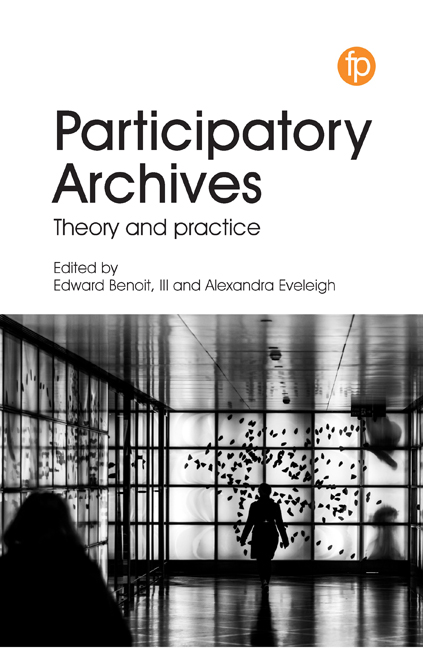Book contents
- Frontmatter
- Contents
- Figures and table
- Notes on contributors
- 1 Defining and framing participatory archives in archival science
- SECTION 1 SOCIAL TAGGING AND COMMENTING
- SECTION 2 TRANSCRIPTION
- SECTION 3 CROWDFUNDING AND OUTREACH
- SECTION 4 ALTERNATIVE AND ACTIVIST COMMUNITIES
- 14 Degrees of mediation: a review of the intersectionality between community and participatory archives
- 15 Activist participatory communities in archival contexts: theoretical perspectives
- 16 Documenting a social movement in real time: the Preserve the Baltimore Uprising 2015 archive project
- 17 Community partnerships and collection development in the Legacy of Ahmed Project
- 18 Challenges, opportunities and future directions of participatory archives
- Notes
- Index
16 - Documenting a social movement in real time: the Preserve the Baltimore Uprising 2015 archive project
from SECTION 4 - ALTERNATIVE AND ACTIVIST COMMUNITIES
Published online by Cambridge University Press: 25 October 2019
- Frontmatter
- Contents
- Figures and table
- Notes on contributors
- 1 Defining and framing participatory archives in archival science
- SECTION 1 SOCIAL TAGGING AND COMMENTING
- SECTION 2 TRANSCRIPTION
- SECTION 3 CROWDFUNDING AND OUTREACH
- SECTION 4 ALTERNATIVE AND ACTIVIST COMMUNITIES
- 14 Degrees of mediation: a review of the intersectionality between community and participatory archives
- 15 Activist participatory communities in archival contexts: theoretical perspectives
- 16 Documenting a social movement in real time: the Preserve the Baltimore Uprising 2015 archive project
- 17 Community partnerships and collection development in the Legacy of Ahmed Project
- 18 Challenges, opportunities and future directions of participatory archives
- Notes
- Index
Summary
Firsthand accounts of Baltimore's two most notable moments of civil unrest and protest, in 1968 and 2015, are eerily similar despite there being nearly 60 years between them. Both events were reactions to controversial deaths in the black community, which led to riots, violence, hundreds of arrests, and significant property damage, but also days of peaceful demonstrations and protest. Although the deaths of Dr Martin Luther King Jr in 1968 and Freddie Gray in 2015 were catalysts for the unrest, frustration with decades of systemic inequality in Baltimore played a significant factor in both events. One significant difference between the riots of 1968 and 2015 has been the ability to document the 2015 Uprising in real time.
Coverage of the 1968 riots exists in a limited capacity as some photographers and videographers captured images and footage of the events. Although an important event, national attention on the assassination of King, and its subsequent effects, drowned out individual focus on the Baltimore riots. Additionally, the contemporary costs of documenting the unrest, including equipment, travel and preservation, precluded amateur participation. As a result, much of what is now preserved is from media footage, with some interviews, oral history interviews and personal archives collected long after these events occurred.
While there are limited firsthand accounts of the 1968 riots, technological advancements enabled everyday citizens to document the 2015 Uprising in real time easily. Technology unavailable in 1968 has been an invaluable factor in a community (and outside the Freddie Gray case, a national) effort to capture as much information as possible about the incident itself, as well as the resulting civil unrest and its aftermath, including community activism efforts and the results of the related criminal and civil cases. Smartphones, web pages, Twitter feeds and other forms of digital media have captured these records, creating a robust, detailed account of these events from many perspectives in multiple formats.
Despite criticism of millennials’ and younger generations’ overuse of the internet, smartphones, laptops, video games and the like, archivists greatly benefited from this technology use in nearly effortless recording and sharing of firsthand media created at the time of a specific incident. Much of the information regularly shared might be disposable or temporary, but these records are of use when created during significant moments in history.
- Type
- Chapter
- Information
- Participatory Archives , pp. 191 - 202Publisher: FacetPrint publication year: 2019
- 1
- Cited by



